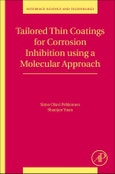Tailored Thin Coatings for Corrosion Inhibition Using a Molecular Approach discusses the fundamentals and applications of various thin coatings for the inhibition of fouling and corrosion from a molecular perspective. It provides the reader with a fundamental understanding of why certain coatings perform better than others in a given environment. Surface analytical and electrochemical techniques in understanding the coating performance are emphasized throughout the book, providing readers with a useful reference on how to pursue a systematic corrosion inhibitor R&D program that involves the testing of coating performance using various, currently available, state-of-the-art laboratory techniques.
Wherever relevant, environmental considerations of the discussed coatings' technologies are highlighted and discussed, with current and upcoming regulatory trends put forth by different governmental organizations.
Please Note: This is an On Demand product, delivery may take up to 11 working days after payment has been received.
Table of Contents
1. Introduction and background 2. Corrosion mitigation definition and challenges: The ultrathin film coatings from self-assembly approach for the mitigation of corrosion 3. The conducting polymeric coatings by electro-polymerization, thermal-curing and oxidative polymerization as effective corrosion barriers 4. Brief introduction to sol-gel technology: The thin film coatings from sol-gel technology for corrosion inhibition 5. The organic-inorganic hybrid as corrosion barriers by a combination of different molecular approaches 6. The superhydrophobic thin coatings as effective barriers to corrosion by different strategies 7. The inorganic film coatings for corrosion protection 8. Brief Introduction to biofouling and biocorrosion: the fabrication of novel antibacterial coatings for biofouling and biocorrosion minimization 9. Conclusions
Authors
Simo Olavi Pehkonen University of Eastern Finland, Department of Environmental Sciences, Kuopio, Finland. Dr. Simo Pehkonen is a Professor of Chemical Engineering at University of Eastern Finland (UEF), Kuopio. Prior to his appointment at UEF he was a Professor of Chemical Engineering at Masdar Institute of Science and Technology in Abu Dhabi and Research Director of Cewic at the Thule Institute at University of Oulu (Finland). Prior to joining Cewic, he was an Associate Professor of Environmental Chemistry in the Division of Environmental Science and Engineering at National University of Singapore (NUS). He obtained his PhD in Environmental Chemistry from CalTech, USA in 1994 and he worked at University of Cincinnati as an Assistant Professor for five years, before joining NUS in 1999. His research interests are environmental photochemistry, materials chemistry including corrosion chemistry and applied kinetics and photochemistry in environmental aquatic systems.Currently his research group is conducting research on aluminium-silicon compound hydrolysis kinetics and metal corrosion in marine systems as well as in simulated drinking water systems as well as on applied catalysis in photocatalytic systems. Dr. Pehkonen has published approximately 90 peer-reviewed research articles in the above areas in top journal such as E S & T, Corrosion Science, J. Electrochem. Soc., Chemical Engineering Science and Industrial and Engineering Chemistry Research, and he also has authored four critical review articles in the above areas. He is a member of American Chemical Society (ACS). Shaojun Yuan Professor, Chemical Engineering, Sichuan University, China. Dr. Yuan was appointed as Associate Professor of Chemical Engineering, Sichuan University, China in 2010. He joined the School of Materials Science and Engineering, Nanyang Technological University (NTU), Singapore to take part in a biomedical project, where he integrated knowledge from endothelial cell biology and antithrombogenicity with advances in surface-initiated radical polymerization for biomedical material applications. The focal area of his research interests are corrosion electrochemistry and polymer chemistry with the emphasis on corrosion electrochemistry and inhibition, novel polymeric adsorbents for wastewater treatment, molecular design of bioactive surface, and nanofabrication.








